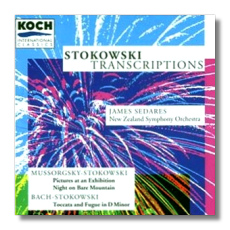
The Internet's Premier Classical Music Source
Related Links
- Latest Reviews
- More Reviews
-
By Composer
-
Collections
DVD & Blu-ray
Books
Concert Reviews
Articles/Interviews
Software
Audio
Search Amazon
Recommended Links
Site News
 CD Review
CD Review
Stokowski Transcriptions

- Modest Mussorgsky:
- Night on Bare Mountain
- Pictures at an Exhibition
- Johann Sebastian Bach: Toccata and Fugue in D minor
- Bach-Webern: Fuga (Ricercata) from The Musical Offering
New Zealand Symphony Orchestra/James Sedares
Koch International Classics 3-7344-2H1 DDD 54:37
All conductors have a stake in Ravel's (to say nothing of Gortchakov's, Caillet's, and Funtek's) orchestration of Pictures at an Exhibition and Rimsky-Korsakov's orchestration of Night on Bare Mountain – no doubt "bare" here to avoid offending the follicularly compromised. In contrast, Leopold Stokowski's orchestrations of these and other works are for his use alone… almost. Without his podium personality and his great orchestras, Stokowski's arrangements often are like beer without alcohol. To his and the NZSO's credit, James Sedares comes close to reanimating Stokowski, and if you don't quite see the white nimbus of hair or hear the suspicious Polish accent, the showman's spirit must have been present when these recordings were made. Sedares seems to have used Stokowski's recordings as a model, so even if these new performances don't tell us anything new about the music or the orchestrations, they do give us the next best thing to echt-Stokowski in splendid digital sound. The NZSO plays as if it wants to be mistaken for the Philadelphia or London Symphony Orchestras, which is more than I could say for it on some previous outings with other conductors.
As for the arrangements themselves, it makes little sense to ask whether Ravel's Pictures is better than Stokowski's. Both are valid, although sometimes Ravel has a clear edge; you almost can hear Stokowski muttering under his breath that he would have used that orchestration if that damned Frenchman hadn't used it first. (Sometimes he uses it anyway.) Stokowski's hyperactive habit of finding a new tone color for almost every phrase can seem fussy, and he cuts sections from Mussorgsky's score that Ravel left alone, but most of the time his arrangement sounds like a flashy chemistry lab demonstration, and that's not a bad thing. As for Night on Bare Mountain and the Bach Toccata and Fugue, Stokowski's orchestrations leave their predecessors in the dust. It is hard for me to listen to Rimsky-Korsakov's prissified version of the former, and alternative arrangements of the latter sound like what "Fantasia" would have looked like if it had been animated by a computer.
The disc closes with Webern's arrangement of more Bach. This was a curious choice because Stokowski's and Webern's styles could not be more different. I like the arrangement, but it seems wrong on this disc, especially when one considers that the remaining time could have been filled with more Stokowski transcriptions. Failing that, let's hope that Sedares and the NZSO have exactly that in mind for their next disc.
Copyright © 1996, Raymond Tuttle


















